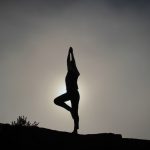Yeah right! You might be asking yourself how a steady and comfortable seat might relate to yoga postures – most of which are anything but steady or comfortable.
We’re talking about asana in terms of being the third of the eight limbs of yoga, as defined in the Yoga Sutras of Patañjali. It defines asana as follows: “Sthiram sukham aasanam” which means, “asana is a steady and comfortable seat.” The Sutras refer to asana in relation to being a posture to be assumed for meditation, and says little more about it — no instructions, and certainly no descriptions of particular asanas.
This seems rather surprising right? The Sutras are one of the main texts of yoga, and it only has one tiny line about the physical aspect. Looking at all the cool, handsome, beautiful yoga teachers out there, who contort themselves into impossible shapes (and still look amazing) you would be forgiven for thinking that asana is the most important part of yoga. In fact, these days we use the words ‘yoga’ and ‘asana’ interchangeably, as when most people talk about yoga, they mean the physical asana practice.
Vice Versa
The Hatha Yoga Pradipika, another of the key texts of yoga, places far more emphasis on asana. In fact it starts with asana, and works up to the subtler aspects of meditation and the mind. You could say that the two texts approach the mind from two different points of view, but the goal remains the same: steadiness, control, and eventually freedom from the mind.
According to the Hatha Yoga Pradipika:
Prior to everything, asana is spoken of as the first part of hatha yoga. Having done asana, one attains steadiness of body and mind, freedom of disease, and lightness of limbs.
In hatha yoga, the body is seen as a tool, or a stepping stone, for exploring our minds and to eventually experience a higher awareness. The hatha yogis found that establishing control of the body eventually led to control of the mind.
Why Do We Practice Asana?
Personally, I came to yoga years ago for exercise. Control of my mind was, erm… far from my mind.
I have stepped on and over (and fallen off!) some of these stepping stones over the years. Sometimes one becomes more relevant than the others, and sometimes it’s necessary to purposely divert your attention to a different level. Now as a teacher, I have found it helpful to be aware of the different reasons people might practice Asana:
- Exercise – This is the most basic and practical level, and everyone understands it. If this is why you do yoga, great! Yoga can certainly make you strong and supple, and it might help you develop the ‘body beautiful’ over time.
- Relaxation – Most people who have tried even one yoga class, will agree that this is a key reason to practice. In my own classes, this has been one the main benefits students have identified. This is not to be sneezed at! In this day and age, where stress and stress-related illness are rife, this is a major reason to practice yoga. This benefit of yoga is being backed up by science more and more these days.
- A Health System – Similar to the last point, yoga is increasingly being seen to have positive effects on physical health. This includes weight loss, stress reduction, sleep, pain relief and many more.
- Therapy – How many times have you felt absolutely awful after a day at work, and then gone to yoga to feel all your tensions disappearing, and your mood lift? Imagine the compound effect of this on your mind and body over many years. Enough said.
- Body-Mind Connection – In modern society, we tend to treat the body and mind as separate entities. In fact, we often treat the body as a solely a support-system for the brain. The yogis tell us that the practice of āsana integrate the body and mind. And the great thing is, you don’t have to take my word for it, you can practice and experience it yourself!
- A Spiritual Practice – This is the most difficult aspect to articulate, as everyone has a different view on spirit and spirituality, and it can often be seen as quite controversial. What I would recommend is that you get a feel for whether this is relevant for you, and whether it is something you can (or want to) explain to others. As a starting point, people often get the sense that spirituality might relate to a sense of their purpose in life, perhaps a deeper knowledge, or something which exists beyond the physical. As the body is seen by the yogis as a link to the spirit, this definition is something you might need to develop over time. The great texts of yoga can be very helpful pointers on your way. However you approach this, make it authentic, and relating to your personal experience.
The Tip Of The Iceberg
Perhaps asana can be seen in this way – it’s the most visible and practical way to work on ourselves. The great thing about it is that it is so accessible! Anyone can try it and experience it for themselves, and they can choose a style which best suits where they are starting from.
The styles are mainly divided into two camps: dynamic and static. The static styles might include Hatha, Kundalini, Iyengar and Bikram. The dynamic styles include Ashtanga Vinyasa, Vinyasa Flow, Viniyoga, Jivamukti and Rocket.
General Points About Asanas
- They are usually classified into beginner, intermediate and advanced levels
- Breathing and awareness are essential components of a solid asana practice
- Sequencing is important, and classes should always end with savasana or relaxation
- Most typical classes usually start with a warm up, sun salutations, standing, balancing, floor / sitting, and relaxation.
- Each pose is usually followed by a counter-pose – e.g. a back bend follows a forward bend
- Timing is important – you shouldn’t practice directly after meals for example
- Some asanas may not be suitable for everyone, depending on health, age or disability, for example
So, after some time of practice, perhaps you find your ‘steady and comfortable seat’ within your mind and body. Then the yogis might say you are ready to go on to deeper levels of yoga practice.













